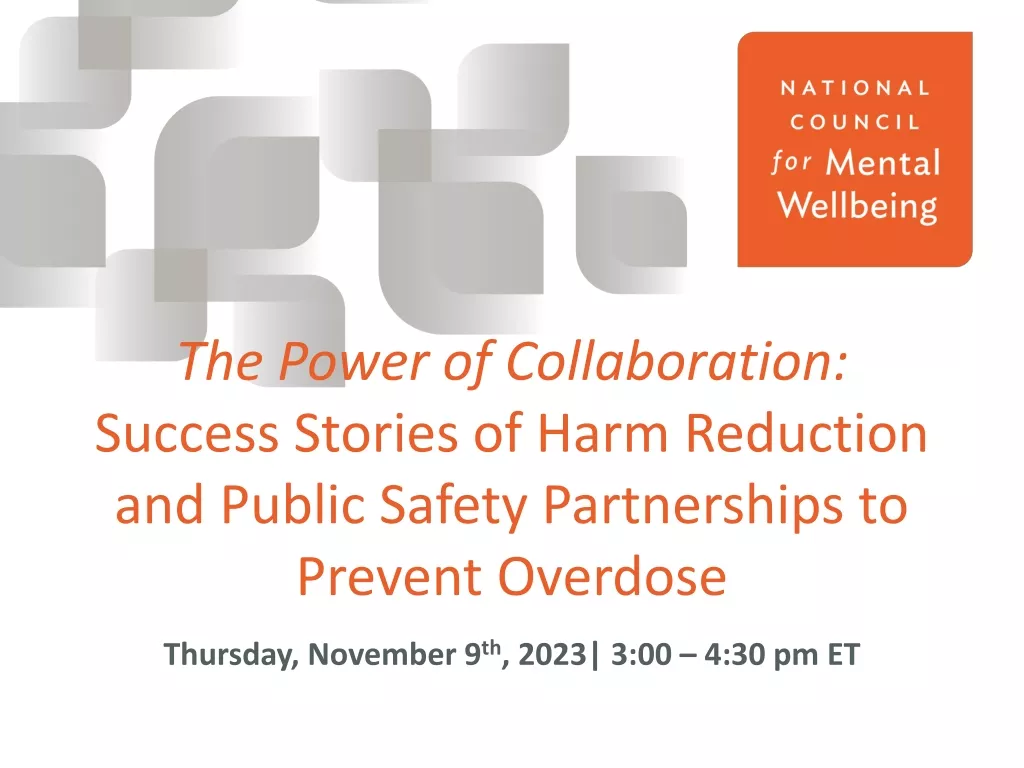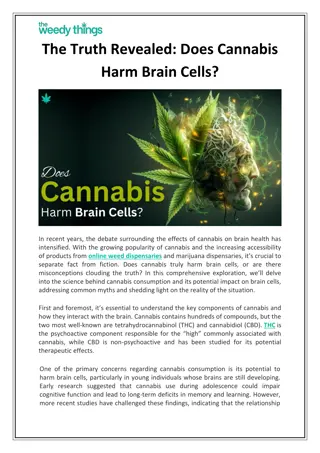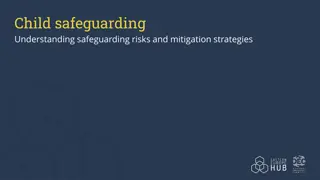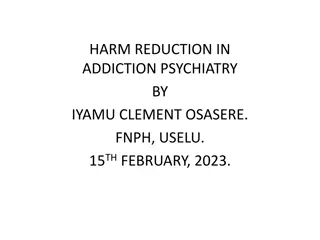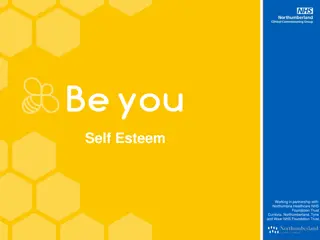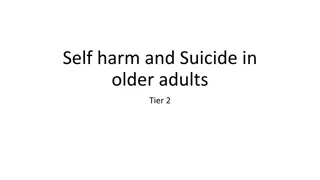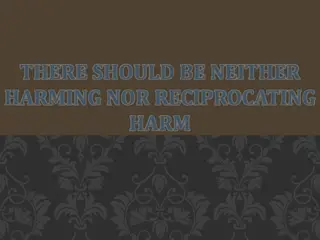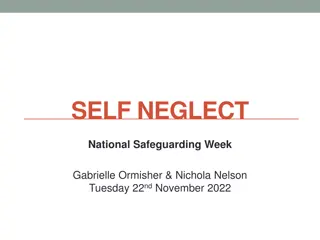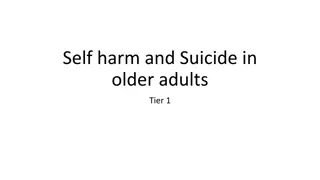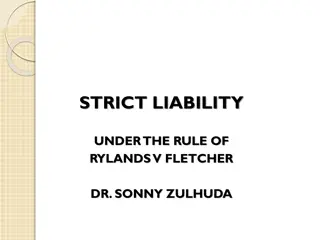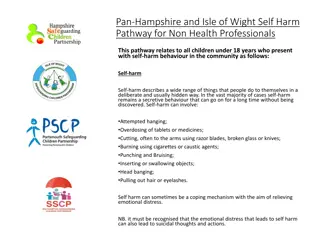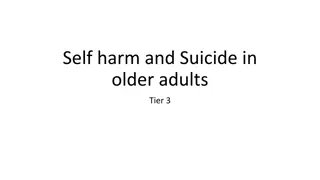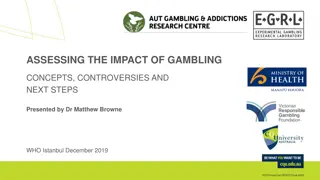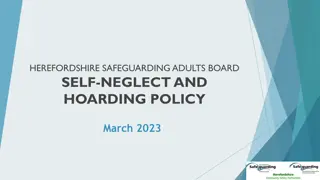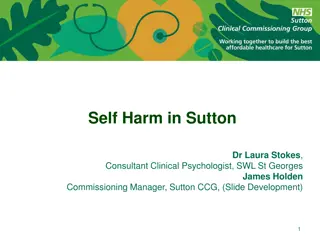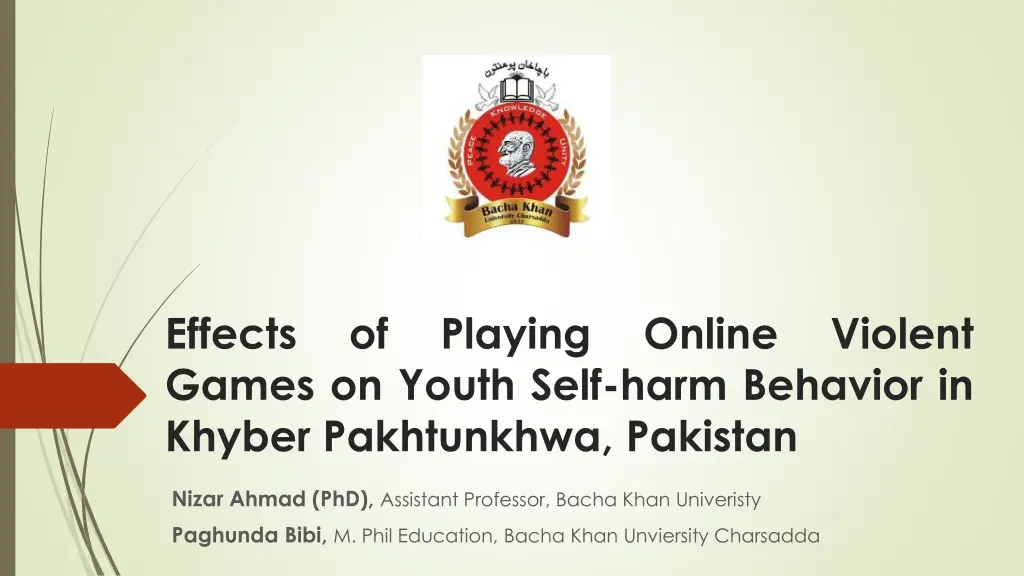
Impact of Playing PUBG on Youth Self-Harm Behavior in Pakistan
"Investigating the link between playing PUBG and self-harm behavior among young adults in Khyber Pakhtunkhwa, Pakistan. The study found associations between daily play time, family awareness, game modes, and self-harm actions. Further research is recommended to explore this topic globally."
Download Presentation

Please find below an Image/Link to download the presentation.
The content on the website is provided AS IS for your information and personal use only. It may not be sold, licensed, or shared on other websites without obtaining consent from the author. If you encounter any issues during the download, it is possible that the publisher has removed the file from their server.
You are allowed to download the files provided on this website for personal or commercial use, subject to the condition that they are used lawfully. All files are the property of their respective owners.
The content on the website is provided AS IS for your information and personal use only. It may not be sold, licensed, or shared on other websites without obtaining consent from the author.
E N D
Presentation Transcript
Effects Games on Youth Self-harm Behavior in Khyber Pakhtunkhwa, Pakistan of Playing Online Violent Nizar Ahmad (PhD), Assistant Professor, Bacha Khan Univeristy Paghunda Bibi, M. Phil Education, Bacha Khan Unviersity Charsadda
Abstract There is plenty of study offering evidence of the nexus between playing violent video games and violent behavior. However, no study has been found on the nexus of violent video games and self-harm. To investigate the relationship between playing online violent games and self-harm, a cross-sectional study was conducted in which data were collected from 241 PUBG players, aged 18-30, in District Charsadda of Khyber Pakhtunkhwa, Pakistan. A self-constructed questionnaire was used to assess the self-harm behavior of young PUBG users aged 18-30. The questionnaire assessed self-harm behavior such as a cut on any parts of the body, medicine overdose, biting, excess smoking or alcohol use, injury through hitting something, pulling out hair or eyebrows, scratching with nails, drinking harmful chemicals, and isolation from family and friends. Data were analyzed through SPSS using T-test and ANOVA statistics. It was found that users daily play time, family awareness about users online game, mood of the game (classic, arcade, and arena), the type of map used by players (Erangel, Livik and Miramar), the mode in which players play the game (solo, duo or squad) were significantly associated with self-harm behavior. The use of servers (Europe, Middle East, or Asia) and the use of perspectives TTP or FPT (Third-person perspective or First Person Perspective) were found non-significantly associated with self-harm behavior. The study provides preliminary evidence of the association of playing PUBG with self-harm behavior of young persons and suggests further studies to find more evidence from different parts of the world.
Introduction Since its release in 2017, Players Unknown s Battleground, shortly pronounced as PUBG, has become increasingly popular around the world, with millions of players logging in daily to play the game. This game craze is unfortunately triggering world s young population to invest their valuable time, money and effort in a no-return business, and therefore needs urgent attention. In PUBG, around 100 players skydive onto a landmass and hunt for arms and ammunition to assassinate others while simultaneously attempting to escape from execution (Al-Qahtani et al., 2020). Social learning theorists have explained the impact of exposure to violence and virtual involvement in a climate of violence on human behavior including aggression and violence. Therefore the negative impact of playing PUBG on human behavior can not be ignored.
Introduction In the start of June 2020, the Pakistan Telecommunication Authority banned Player Unknown s Battlegrounds or PUBG as it is more widely known, citing several complaints about it being addictive , a waste of time and its potential negative impact on the physical and psychological health of children. The bane lasted few months, however, after two cases of familicides and few cases of suicides being linked with the PUBG addiction, the Punjab police wrote several letters to ban the game (Shahzad, 2022). Police reports linked these cases with PUBG addiction but this is not empirical tested on a large population. However, this provides a hypothesis to be tested empirically by getting data from PUBG users. Moreover, suicide or familicide is an extreme form of self-harm or violence. PUBG addiction may not always push its users to such a severe extent but they can also perform less severe acts of self-harm such as injuring themselves by cutting or biting and scratching the body with nails, that needs to be tested. Therefore, this study attempts to investigate the relationship between PUBG use and self-harm behavior.
Methodology To investigate the relationship between playing online violent games and self-harm, a cross-sectional study was conducted in which data were collected from 241 PUBG players, aged 18-30, in District Charsadda of Khyber Pakhtunkhwa, Pakistan. Sampling was done through snowball method. Initially, some PUBG players were identified through personal contacts, then, these PUBG players were asked to help in identifying other fellow PUBG players for data collection. A self-constructed questionnaire was used to assess the self-harm behavior of young PUBG users aged 18-30. The questionnaire assessed self-harm behavior such as a cut on any parts of the body, medicine overdose, biting, excess smoking or alcohol use, injury through hitting something, pulling out hair or eyebrows, scratching with nails, drinking harmful chemicals, and isolation from family and friends. Data were analyzed through SPSS using Frequency and Percentages, T-test and ANOVA statistics to understand the difference of self-harm behavior in relation to PUBG use.
Result and Discussion The Extent of Self-harm among Young PUBG Players PUBG players were asked about their experience of self in the last year. The self-harm behavior was noted on various dimensions of self-harm. The extent of Self-harm behavior among youth ranges from 13 percent to 28 percent on various dimensions of self-harm. For example, on the lowest, about 13 percent of PUBG players reported that they had burned themselves, while on the upper limit about 28 reported that they had hit something that had injured them (for more details see table in next slide). Hence, it shows that about 30 percent of PUBG players are at risk of self- harm. This seems a quite large number and the issue needs serious attention from scholars to further dig out the causes and how PUBG is influencing self-harm behavior.
Self Harm Behavior of PUBG Players S. No Statement about self-harm behavior Response Yes 57(23.7%) No 184 (76.3%) 1 Have you ever cut your arms, legs or any other area of your body in the last year? Have you taken or overdose medicine which is harmful in the last year? 41(17.0%) 200(83.0%) 2 3 Have you increased or started smoking or use of alcohol in the last year? 53(22.0%) 188 (78.0%) 194(80.5%) 47(19.5%) 4 Have you ever bite yourself with teeth? 32(13.3%) 209(86.7%) 5 Have you burned yourself? 69(28.6%) 172 (71.4%) 6 Have you hit anything that injured or hurtled you? 37 (15.4%) 204 (84.6%) 7 Have you ever pull out hairs, eyebrows, or eyelashes with the over intention of hurting yourself? Have you ever severely scratched or pinch with fingernails or other object? Have you drunk harmful chemicals due to high depression? 34(14.1%) 207(85.9%) 8 43(17.8%) 198(82.2%) 9 64(26.6%) 177(73.4%) 10 Have you tried to isolate yourself from family and friends?
Time Used Playing PUBG and Self-har ANOVA relationship between excessive use of the game and self- harm behavior. A significant difference (p=.002) was noted among various groups of users on the basis of the time spent on playing PUBG game in relation to self-harm behavior (for details see table in next slide). It can be said that those who spend less time on PUBG are at the lowest risk of self-harm behavior. statistics was applied to understand the
ANOVA Self harm behavior Sum of Squares 77.290 Mean Square 38.645 Hours of PUBG Use Daily df 2 F 6.353 Sig. .002 Between Groups Within Groups 1447.672 238 6.083 Total 1524.963 240 Descriptives Self Harm Behavior 95% Confidence Interval for Mean Lower Bound 1.3701 Daily time of game 0 to 4 hours 170 1.7353 Std. Std. Error .18498 Upper Bound 2.1005 Deviation 2.41186 N Mean Minimum .00 Maximum 10.00 4 to 8 hours 52 8 to 12 hours Total 2.1346 3.8421 2.48942 2.87254 .34522 .65900 1.4416 2.4576 2.8277 5.2266 .00 .00 10.00 10.00 19 241 1.9876 2.52072 .16237 1.6677 2.3074 .00 10.00
Family knowledge about Self-harmSelf harm A T-test was applied to understand the difference in self-harm behavior between PUBG users whose families are aware of their involvement in playing PUBG and those whose families are not aware. A significant (p=.004) difference was found between the two groups. It is noted that group with families unaware of their playing PUBG had a higher mean score and at higher risk of self-harm in comparison to PUBG players who s families were aware (see next slide)
Group Statistics Do your family know that you are playing PUBG Std. Deviati on Std. Error Mean N Mean Family knowledge about PUBG AND Self-harm 2.2863 yes 172 1.7035 69 2.69572.9270 .17433 Self harm behavior 4 no .35238 8 Independent Samples Test Levene's Test for Equality of Variances t-test for Equality of Means Self-Harm Behavior 95% Confidence Interval of the Difference Std. Error Differen ce Mean Differen ce Sig. (2- tailed) F Sig. t df Lower -1.68990 Upper -.29443 Equal variances assumed 8.539 .004 -2.801 239 .006 -.99216 .35419 Equal variances not assumed -2.524 102.909 .013 -.99216 .39314 -1.77188 -.21245
Mode of PUBG GAME & Self-harm behavior PUBG is played in various modes such as classic, arcade and arena. ANOVA statistic was used to assess the difference of self-harm behavior among players of different modes. The result showed a significant difference (p=.002) among the three mode users with respect to mean score of self-harm (see next slide). The arcade mode user had a high mean score followed by arena and classic. Arcade mode users can be said of higher risk of self-harm
ANOVA Self-harm behavior Mode of PUBG GAME & Self-harm behavior Sum of Squares 75.565 Mean Square 37.782 df 2 F 6.204 Sig. .002 Between Groups Within Groups 1449.398 238 6.090 Total 1524.963 240 Descriptives Self-harm behavior 95% Confidence Interval for Mean Mode of Game Classic Arcade Arena Total Std. Deviation 2.28113 3.00539 2.47918 2.52072 N Mean 1.6471 3.1087 2.0000 1.9876 Std. Error .18442 .44312 .38255 .16237 Lower Bound Upper Bound 1.2827 2.2162 1.2274 1.6677 Minimum .00 .00 .00 .00 Maximum 10.00 10.00 10.00 10.00 153 46 42 241 2.0114 4.0012 2.7726 2.3074
Map Type Used and Self-Harm Behavior PUBG player uses various maps while moving in the game after targets. ANOVA test was used to assess the difference of self-harm among different map users. A significant association (p=.034) was found with a higher mean score of Miramar map users (see next slide for details). It could be said that Miramar map users are more comparison to other map users. inclined to self-harm in
ANOVA Self-harm behavior Sum of Squares 42.626 Mean Square 21.313 df F Sig. Between Groups Within Groups Total Map Type Used and Self-Harm Behavior 2 3.422 .034 1482.337 238 6.228 1524.963 240 Descriptives Self-Harm Behavior 95% Confidence Interval for Mean Lower Bound 1.3341 Std. Type of Map used N Mean Std. Error Minimum Maximum Deviation Upper Bound 2.1297 Erangle 138 1.7319 2.36316 .20117 .00 10.00 Livik 61 1.9508 2.47942 .31746 1.3158 2.5858 .00 10.00 Miramar 42 2.8810 2.91508 .44981 1.9726 3.7894 .00 10.00 Total 241 1.9876 2.52072 .16237 1.6677 2.3074 .00 10.00
Number of Players and Self-harm Behavior Likewise, the number of players i.e. playing solo, duo or in a squad was assessed through ANOVA test. The result showed a significant difference (p=.004) between the three groups of players with respect to their self-harm behavior. The solo and duo players had a high mean in comparison to squad players. This shows solo and duo players are at more risk of self-harm in comparison to squad players.
ANOVA Self-harm behavior Sum of Squares 69.766 Mean Square 34.883 df F Sig. Number of Players and Self-harm Behavior Between Groups Within Groups Total 2 5.705 .004 1455.196 238 6.114 1524.963 240 Descriptives Self-harm behavior 95% Confidence Interval for Mean Std. Minimu m Maximu m Number of Players N Mean Std. Error Deviation Lower Bound 1.5791 Upper Bound 4.1709 Solo 24 2.8750 3.06895 .62645 .00 9.00 42 2.8571 2.89298 .44640 1.9556 3.7587 .00 10.00 Duo Squad 175 1.6571 2.26851 .17148 1.3187 1.9956 .00 10.00 Total 241 1.9876 2.52072 16237 1.6677 2.3074 00 10.00
Type of Server used and Self-Harm Behavior Various types of Servers such as Asia, Europe and Middle East are used by PUBG players. It was tested to understand the difference among the users of these servers with respect to self-harm behavior. However, a non-significant difference (p=.931) was found which shows no influence of the server being used to play.
ANOVA Self-Harm Behavior Sum of Squares .923 Mean Square .461 df F Sig. Type of Server used and Self-Harm Behavior Between Groups Within Groups Total 2 .072 .931 1524.040 238 6.404 1524.963 240 Descriptives Self-harm 95% Confidence Interval for Mean Std. Type of Server N Mean Std. Error Minimum Maximum Deviation Upper Bound 2.4252 2.5523 2.7730 2.3074 Lower Bound 1.5385 1.2810 1.3965 1.6677 Europe Middle east Asia Total 110 72 59 241 1.9818 1.9167 2.0847 1.9876 2.34611 2.70498 2.64111 2.52072 .22369 .31878 .34384 .16237 .00 .00 .00 .00 10.00 10.00 10.00 10.00
Conclusion The study concludes that playing PUBG influences youth behavior including their self-harm behavior. Various dimensions of PUBG game such as time spent, knowledge of family about PUBG use, the mode of the game, number of players and map used during game are related to self-harm behavior of PUBG players. The study provides preliminary evidence of the association of playing PUBG with self-harm behavior of young persons and suggests further studies to find more evidence from different parts of the world. Further, public health interventions are needed for PUBG players with abnormal behavior and families of the PUBG users need to be sensitized for playing their role to be alert and keep an eye on their children to avoid their excessive use of PUBG.
Many thanks for your time and interest in the study. I can be reached at nizar@bkuc.edu.pk

